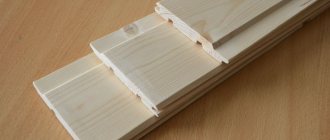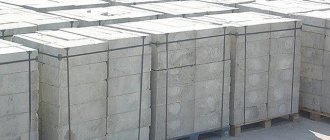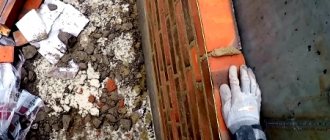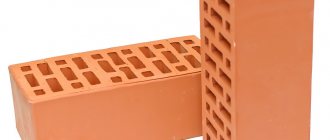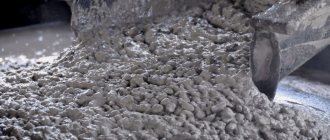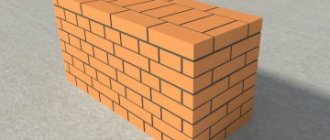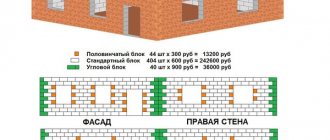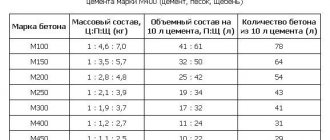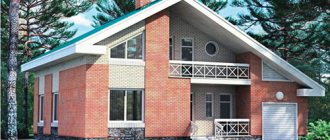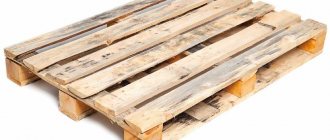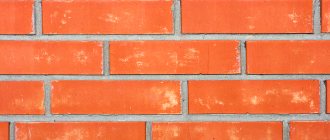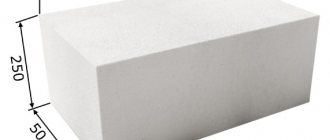Kinds
Each type of building material differs in certain characteristics, which determines its use in the construction of a particular structure.
To correctly determine the number of bricks in 1 m2 of masonry, use the following information:
- type of building material;
- the method of masonry, determined taking into account the required thickness of load-bearing walls;
- at a separate stage the size of interior partitions is specified;
- dimensions of window and door structures.
Based on the raw materials used in production and manufacturing methods, brick is divided into several subtypes:
- ceramic;
- silicate;
- fireproof clay;
- compressed.
According to the application options, brick stone can be used for construction and facing, and according to its filling – hollow or solid.
Material sizes
When calculating how many pieces there are in 1m2 of wall, it is recommended to pay attention to the type of stone used for construction work. Only after this is it possible to accurately calculate the required material. There are several types of brick stone with certain sizes:
- single – 25 by 12 by 6.5 cm;
- one and a half – 25 by 12 by 8.8 cm;
- double – 25 by 12 by 13.8 cm.
For construction work, any type is used, but if you need to clarify how many facing bricks are in 1m2 of masonry, then calculate the need for a single type. A house with such finishing will look aesthetically pleasing.
Masonry options
Before determining how many bricks are needed per square meter, a masonry option is selected. Particularly popular are:
- block Rows consisting of long edges of stone are laid out, alternating with laying the end face. The joining seams match;
- Gothic The layout is carried out in a similar way, but with an offset;
- track. All rows are laid out with a long edge, offset by half a brick;
- Lipetskaya Every three rows laid with a long edge, a row is made with the end part;
- tychkovaya. Laying is done end-to-end, with a certain shift;
- spoon The laying is carried out using the spoon edge of the brick, shifting the stone by half or a quarter;
- Brandenburg. Two stones are laid out with the spoon side, the third - with a poke. The offset is carried out in such a way that the butt edge is located above the junction of two stones laid with the spoon side.
In addition to the listed methods, masonry is carried out using the cross, Dutch, Flemish, and Silesian methods. They also use a chaotic method, not following a specific pattern and arranging the products chaotically.
To accurately determine the number of bricks in 1m2, you will have to calculate the dimensions of the façade and interior walls as accurately as possible.
Calculation of wall area
To determine the working surface, appropriate calculations should be carried out. To do this, measure the length and height parameters, and multiply the resulting values. Data for each wall is determined in a similar way, after which all indicators are added up.
The dimensions of doors and windows are specified, their total area is calculated, and this value is subtracted from the area of the façade surface. The data obtained means exactly the area that needs to be covered with brick stone.
A certain indicator is taken as the basis for the calculation. There are 480 red stones per cubic meter of the usual size 25 by 12 by 6.5 cm. The value is convenient not only for making calculations, but also for purchasing material and transporting it.
To set the consumption rate per 1 m2 of masonry, specify the wall thickness parameter, which depends on the method of laying out the products:
- in ½ brick – 12 cm;
- in brick – 25 cm;
- one and a half stones - 38 cm;
- in two – 51 cm;
- in two and a half products - 64 cm.
For the climatic conditions of Russia, the optimal solution is a wall of 2.5 stones. Also take into account the number of floors in the house, the type of floors between floors, and the features of the structure. Having specified the thickness, find the perimeter of the object and the height of the walls. By multiplying the resulting values, you will find the area of the building.
Having finished with the calculation steps, move on to the material requirements for the facade.
When specifying how many elements are in one square meter, remember that in order to design corners and openings, building materials will have to be added, taken into account and a certain reserve laid down.
Calculation taking into account seams
Theoretically, more accurate numbers can be calculated. You can take into account the length of horizontal and vertical seams and calculate extremely accurate dimensions (different batches may have errors). In fact, such calculations will be too complex and meaningless, so you need to understand that all calculations are approximate.
To calculate the consumption of bricks per 1 cubic meter, you can use these indicators:
| Standard size | Without solution, pcs. | With solution, pcs. |
| Single | 512-513 | About 395 |
| One and a half | 378-379 | About 300 |
| Double | 242-243 | About 200 |
For calculations, it is often necessary to use the consumption of bricks per 1 m2 of masonry. How many bricks per square meter of masonry will depend on additional factors. First you need to decide on the weight of the wall. Depending on the purpose of the building or climatic conditions, walls can be erected:
- Half a brick (wall thickness 120 mm);
- In one (wall thickness 250);
- 1.5 (wall thickness 380);
- Two (wall thickness 510);
- 2.5 (wall thickness 640).
The thickness of the wall will determine how many bricks are in 1m2.
So how many bricks are in 1m2? Use a calculator for calculations. Let's carry out the calculation, for example we will use the same one-and-a-half. First, let's calculate the total area in one brick. With dimensions of 250x120x88, we convert the numbers to meters. 0.25*0.088, we get 0.022 square meter. This is that part of the brick in 1m2 of masonry. Now divide by 1 m2 by 0.022, we get 45.45. Brick mortar is not included in this calculation. The figure indicating the amount of brick in 1m2 will be approximate for ease of calculation; you can use this table, but during construction you can get away from these figures.
| Without solution | |||||
| Size: | 0,5 | one | 1,5 | two | 2,5 |
| Single | 60 | 128 | 190 | 258 | 320 |
| One and a half | 44 | 96 | 139 | 190 | 230 |
| Double | 30 | 61 | 90 | 120 | 150 |
This table indicates how many bricks are in 1m2 with mortar.
| Calculation taking into account the masonry mixture joint of about 10 mm. | |||||
| Size: | 0,5 | one | 1,5 | two | 2,5 |
| Single | 52 | 103 | 1154 | 205 | 256 |
| One and a half | 40 | 79 | 79 | 157 | 196 |
| Double | 27 | 53 | 53 | 105 | 131 |
Solution consumption
The strength of the masonry being built depends entirely on the cement material, its composition and manufacture. When determining the amount of mortar mixture, one should take into account the moisture absorption of the material, the construction time, and the porosity of the stone structure.
For porous bricks, more mortar is needed, so the batch is increased by twenty percent of the volume.
The normalized mixture consumption for façade cladding is determined by the wall thickness. If it is equal to a quarter of the stone, then the amount of masonry mixture is selected taking into account the brand of cement:
- M 100 – 5 kg;
- M 75 – 4 kg;
- M 50 – 2.5 kg.
You can determine how much masonry mixture goes per square meter of wall built from silicate or ceramic bricks:
- with a thickness of facing masonry of 250 mm - 0.62 m² (silicate or ceramics);
- 380 mm thick – 0.095 m² (hollow);
- 250 mm wide – 0.05 m² (hollow).
For example, if the expected consumption of masonry mortar is 1/3, then for a hollow brick laid in a wall 380 mm wide, the calculation is performed as follows: 0.095 x 490, resulting in a total of 47 kg.
With proper preparation of the mortar mass, the amount needed per 1 sq. m, will be close to the normalized volume.
Brick house projects
Number of projects 55
- 5 rooms
- 3 bathrooms
Koktebel House Project
- To favorites
- 237² Total area
- 12 x 14m Construction area
from 7,260,800 rub.
Construction time individually
- 8 rooms
- 2 bathrooms
House Project Neva 234
- To favorites
- 230² Total area
from 2,964,750 rub.
Construction time individually
- 4 rooms
- 2 bathrooms
House Project Dnepr 154
- To favorites
- 150² Total area
from 2,105,250 rub.
Construction time individually
- 3 rooms
- 1 bathroom
Malyutka House Project
- To favorites
- 61² Total area
- 10 x 8m Construction area
from 1,952,000 rub.
Construction time individually
- 6 rooms
- 3 bathrooms
House Project Danube 203
- To favorites
- 200² Total area
from 2,480,250 rub.
Construction time individually
- 4 rooms
- 2 bathrooms
Arkhangelsk House Project
- To favorites
- 198.1² Total area
- 9 x 13m Construction area
from 6,147,200 rub.
Construction time individually
- 5 rooms
- 2 bathrooms
Comfort House Project
- To favorites
- 162² Total area
- 9 x 9m Construction area
from 3,235,000 rub.
Construction time individually
- 6 rooms
- 2 bathrooms
Terra Plus House Project
- To favorites
- 200² Total area
- 11 x 9m Construction area
from 3,966,000 rub.
Construction time individually
- 8 rooms
- 3 bathrooms
Provence House Project
- To favorites
- 310² Total area
- 15 x 15m Construction area
from 4,092,000 rub.
Construction time individually
- 5 rooms
- 3 bathrooms
Sirocco House Project
- To favorites
- 184² Total area
from 3,500,000 rub.
Construction period 120 days
- 2 rooms
- 2 bathrooms
Sirius House Project
- To favorites
- 121² Total area
- 8 x 8m Construction area
from 2,632,000 rub.
Construction time individually
- 6 rooms
- 3 bathrooms
Project House Amur 245
- To favorites
- 250² Total area
from 3,654,000 rub.
Construction time individually
- 5 rooms
- 3 bathrooms
Breeze House Project
- To favorites
- 183² Total area
from 3,194,000 rub.
Construction period 120 days
- 5 rooms
- 2 bathrooms
Don 265 House Project
- To favorites
- 260² Total area
from 3,621,000 rub.
Construction time individually
- 5 rooms
- 3 bathrooms
Classic House Project
- To favorites
- 212² Total area
- 12 x 11m Construction area
from 2,862,000 rub.
Construction time individually
- 8 rooms
- 3 bathrooms
House Project Novgorod
- To favorites
- 405² Total area
- 18 x 10m Construction area
from 5,346,000 rub.
Construction time individually
- 6 rooms
- 2 bathrooms
Agave House Project (with garage)
- To favorites
- 232² Total area
- 10 x 11m Construction area
from 3,317,600 rub.
Construction time individually
- 4 rooms
- 2 bathrooms
Project House Amur 202
- To favorites
- 200² Total area
from RUR 2,523,750
Construction time individually
- 6 rooms
- 2 bathrooms
Terra House Project
- To favorites
- 200² Total area
- 9 x 11m Construction area
from 3,966,000 rub.
Construction time individually
- 10 rooms
- 2 bathrooms
Project House Amur 325
- To favorites
- 300² Total area
from 3,935,250 rub.
Construction time individually
View all projects
Construction is a serious and expensive business. To save money wisely, you need to correctly calculate the amount of building material needed. Therefore, we figure out how to calculate the consumption of mortar per 1 m³ of brickwork - taking into account the ingredients of the masonry mixture and the type of brick.
The consumption of mortar is influenced by many factors, for example, the hollowness of the brick. Source sense-life.com
How to correctly calculate the number of bricks
Carrying out construction work involves making the necessary calculations for the material in one cubic meter, but many prefer to determine the consumption of bricks per 1 m2 of masonry, using special tables for this.
To begin the calculations, you should clarify what size material is used in the work. All that remains is to find out the thickness of the walls, and you can begin work on determining the need for building materials.
We proceed as follows:
- using a known method, we find the area of the façade walls, existing openings, and specify the value suitable for finishing by subtracting the area of doors and windows from the size of the walls;
- Now you can calculate how much facing brick is in 1m2 of masonry if it is made of half a single stone. To do this, we multiply the values of length and height, resulting in the area of the product;
- Now, in order to calculate the need for facing bricks per 1 m2, it is necessary to divide the unit of area by a similar parameter of the stone.
This way we will determine how many bricks are in one square of the wall in its “pure” form. Do not forget that when constructing masonry, a mortar mixture is also used, and during calculations you should take into account the thickness of the masonry joints, adding one vertical and one horizontal joint to the material parameters.
With a seam equal to one centimeter and a length of brick stone of twenty-five centimeters, adding both values, we get a value of 26 cm, which when converted to meters will be 0 26 m. Now we increase the parameter of the stone by the size of the horizontal seam section, convert it to the appropriate units and we get 0.075 m. In this case, the volume of one stone will be equal to 0.0195 m2.
To determine how many bricks are in 1 m2 of masonry, all that remains is to divide the unit of area into the new dimensions of the stone, taking into account the mortar. Knowing the number of products in 1 m2 of cladding, you can easily determine the total need by multiplying this value by the previously established surface area.
Having received the result, do not forget to add to it a reserve of five percent for the battle.
How many bricks should there be in 1 m2 when the dimensions of the product are 250 x 120 x 65 mm? In this case, its consumption is determined taking into account the masonry method. The fastest and most cost-effective way is to build walls with half a stone, with the spoon edge facing outward. In this case, the wall thickness is twelve centimeters, and half as much brick is used per 1 m2. True, this construction option involves the use of insulating material.
The method of laying half a brick stone involves placing products with a butt edge. In this case, the thickness of the wall is twenty-five centimeters, but the amount of brick in 1 m2 of half-brick masonry will increase in this case. The walls will withstand any load, distributed evenly.
A structure with a wall thickness of thirty-eight centimeters is more durable. In this case, the masonry is made of one and a half stones. Using the already known algorithm, you can easily determine how many one-and-a-half bricks are in 1 m2 of masonry.
To build houses and other structures, they use masonry with a couple of stones, building walls fifty-one centimeters thick. If you use two and a half stones, the walls will be sixty-four centimeters long and do not need insulating material.
If masonry work is carried out using solid bricks five to eight centimeters wide, then its consumption is reduced by about twenty percent. It is possible to reduce the consumption of brick stone due to the well method of laying, carried out in parallel lines “half a stone” with vertical or transverse type jumpers connecting them.
The calculations are based on the number 480 if the brick material has standard parameters. Any calculation before construction work is carried out taking into account this indicator and the masonry technique.
To establish the volume of a single brick in 1 m2 of masonry, built in one product, it is necessary to divide the standard value of 480 by four, ultimately obtaining 120 products. When building a warm building of two or two and a half stones, you can easily determine how much red brick is in 1 m2.
Quantity of building materials
Before calculating how many bricks are in 1m2 of masonry, you need to take into account several additional factors:
- The width of the joints (the width of the mortar when laying);
- Size of material used.
Many people do not pay attention to such a small detail as the width of the masonry joint. But per 1 cubic meter. as a rule, it accounts for from 0.2 to 0.3 of the total volume of the masonry. Quite often, builders neglect to take into account the mortar, and when building a private house, the volume of work will be large, which will leave a lot of unused material, so you need to calculate in advance how many bricks are needed.
The standard ones are:
- Single (spoon part width 250 mm, height 65, butt part width 120)
- One-and-a-half (the width of the spoon part is 250 mm, the height is 88, the width of the butt part is 120)
- Double (spoon part width 130 mm, height 206, butt part width 176)
They exist in other shapes and will have a different number of bricks per 1 m2 of masonry; bricks per 1 m2 of masonry can be calculated using similar formulas. Some of them are special-purpose (from which arches are made), their number can be counted individually, since they are used to a limited extent on construction sites. Other parts are foreign made or made to order.
When builders do not take into account the volume of mortar, they count the number of bricks in 1 cubic meter. calculating the volume of one piece. For example, the dimensions of a one-and-a-half brick are 250 mm. by 120 by 88. We convert the linear dimensions into m² and then into m³, we get 0.25 m * 0.12 m * 0.088 m. We get 0.00264 cubic meters. Now 1 cubic meter, divide by the resulting figure and get 378.78 one and a half. When using single bricks, it turns out about 512 bricks per 1 cubic meter. And if we take the volume of the solution as 0.2, then with one and a half, the quantity is reduced to 300 pieces. With a single one, the quantity is reduced to 400 pieces. It would be a mistake not to take into account the mortar and count brick by brick, especially if the volume of work is large.
Pallets with building stone
The building material you purchase is delivered to the site in standard briquettes, while the manufacturer independently determines the number of bricks and the layout option on the pallet. If the latter has standard parameters of 1.3 x 1 m, 560 solid one-and-a-half stones and 480 hollow stones are placed on it. If laying on a briquette is done crosswise, then single and one-and-a-half stones will fit 226 and 200 pieces, respectively.
Having found out how many bricks there are in 1 m2 of masonry, made in half a brick, taking into account the mortar, you can easily determine how many pallets you need to purchase. This will allow you to select the required number of stones for one batch and determine transport for delivery.
Recommendations from experts
Having learned to determine how much sand-lime or other brick is in 1 m2 of surface, you can order the required amount of such building material without much difficulty. The data obtained from calculating the area of the façade walls allows you to purchase brick material determined by the design specifications.
If you don’t want to determine on your own how many bricks per m2 of 120 mm thick masonry, just use special calculators on construction sites. By the way, with their help you will find the number of products for any wall, determine the need for one-and-a-half and other bricks per 1 m2.
Remember that the values of windows and doors are subtracted from the entire area of the façade sections so as not to purchase excess material, and a few percent is added to the final requirement for the battle.
Important nuances
After calculating how many building blocks will be needed to lay each m2 of wall, the resulting value is increased by 5-7%. This gap is necessary to cover defects and damage, which is inevitable when transporting building materials.
How many blocks are needed to construct a particular building? To determine the final consumption of briquettes, first calculate the total area of all the walls of the object being built. To do this, the height of the walls is multiplied by their length and the dimensions of the windows and entrance doors provided for in the construction project are subtracted.
The final area value is multiplied by the number of bricks in each m2 of masonry. The required number represents the number of clinkers required for the construction of a given facility.
When purchasing building materials, it is necessary to take packages from the same batch, since blocks from different deliveries may differ in shade. This color difference is not particularly noticeable when the bricks are in the package, but will be noticeable once the masonry is formed.
Correctly carried out calculations will not only determine how many bricks will be needed to erect a building, but also significantly reduce the cost of purchasing building materials.
